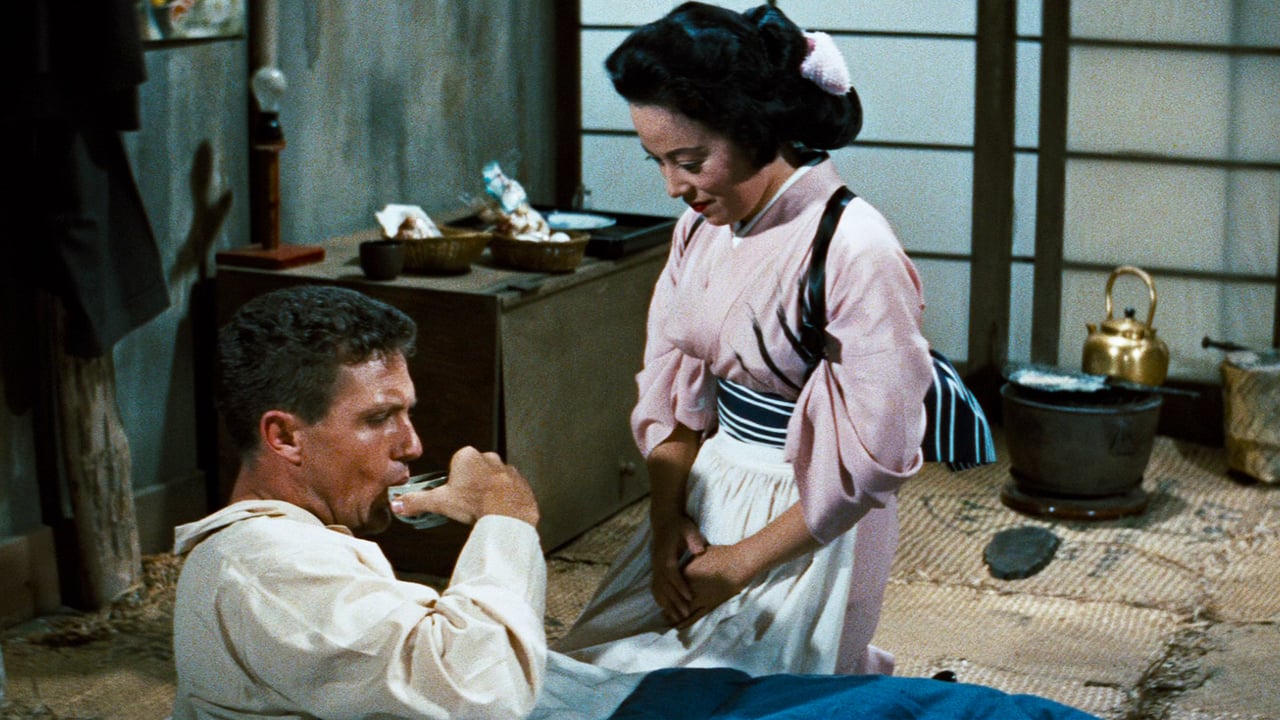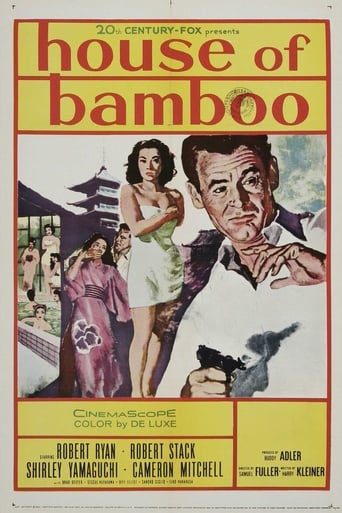

Robert Stack plays an undercover Army Investigator in Tokyo, Japan, who infiltrates an American mob run by Robert Ryan in "Steel Helmet" director Samuel Fuller's foreign crime saga "House of Bamboo" with Cameron Mitchell, Deforrest Kelly, and Brad Dexter. After hoodlums hit a military train laden with guns and ammunition guarded by Americans and Japanese and kill the only American guard, the U.S. Army dispatches an agent to masquerade as Eddie Spanier. Initially, to find out who his adversaries are, the fake Eddie (Robert Stack of "The Untouchables") tries to muscle in on the pachinko parlors that belong to Sandy Dawson (Robert Ryan of "The Set-Up"), but he doesn't get far before Dawson reports him to the authorities. Once he is out of jail, Eddie shows up at Sandy's place, and they strike an understanding after Sandy informs him that he protects the places that Eddie tried to compromise. Along the way, Eddie makes us of the real Eddie Spanier's Japanese wife, Marito (Shirley Yamaguchi of "Madame White Snake"), and she masquerades as Eddie's kimono.The action is fast and thick in Harry KIeiner's screenplay, and Fuller provided the original story which he drew from the gritty 1946 thriller "The Street with No Name." Virtually nothing carries over from the American-set "The Street with No Name" to "House of Bamboo" except for the chief villain's use of a P-38 automatic pistol that only he uses when he commits a crime. "House of Bamboo" qualifies as an above-average effort, and Joe MacDonald's widescreen cinematography of Tokyo is a big plus. Indeed, Fuller and MacDonald make maximum use of Mount Fuji. After Sandy takes Eddie into his gang, our stalwart hero makes an enemy of Sandy's second-in-command, Griff (Cameron Mitchell of "Garden of Evil"), who suspects that Sandy likes Eddie too much. Meantime, Sandy thinks Griff has blown his buttons, and he refuses to include him on a major bank heist. Eddie manages to get a note out to the authorities via , but Westerner on the inside at police headquarters alert Sandy about an intruder. Mistakenly, Sandy murders Griff in his bath tub, and then he learn later that Griff wasn't the stooge pigeon.The notion of an American gang of criminals operating in Tokyo must have seemed unusual at the time, and the setting and the criminals both make "House of Bamboo" a different kind of crime thriller. Fuller and Kleiner provide a modicum of Japanese language, but the dialogue isn't as crisp and incisive as it typically is in a Fuller movie. "House of Bamboo" emerges as an off-beat, occasionally exciting, crime thriller with some gunplay.
... View MoreWest meets East in this Japan-set noir tale from screenwriter Harry Kleiner and director Samuel Fuller. It drops characters and viewers into a post-war Japan with citizens leading very ordinary lives. The colour photography and the CinemaScope aspect ratio really add dynamic visuals to the absorbing story. The always excellent Robert Ryan leads a solid cast. An element of romance does slow down the story a fair deal, but things pick up for an intriguingly staged finale that takes place at a carnival.Robert Stack plays Eddie Spanier, a newcomer to Tokyo who makes enough of a nuisance of himself to get noticed by smooth criminal Sandy Dawson (Ryan), who uses pachinko parlors as a front for various enterprises. Eddie, who's keeping a secret from Sandy and his gang, finds himself romantically involved with Mariko (Shirley Yamaguchi), the Japanese wife of a deceased American officer.Fuller takes full advantage of what would have been an unusual setting to American audiences of the 1950s. There are a fair amount of sights and sounds to take in. His opening set piece is a striking train robbery in a snowy environment, and his ending is equally enjoyable. The story ultimately isn't that memorable, but it's reasonably paced and easy enough to follow. Ryan, Stack, and the beautiful Yamaguchi are joined by an eclectic group of actors: Cameron Mitchell, Brad Dexter, Sessue Hayakawa, Biff Elliot, Harry Carey Jr., John Doucette, DeForest Kelley, and Robert Quarry.No, this may not be a great film, but it is an interesting and entertaining one, and it does keep one watching.Seven out of 10.
... View MoreHouse of Bamboo is directed by Sam Fuller who also co-writes with Harry Kleiner. It stars Robert Ryan, Robert Stack, Shirley Yamaguchi and Cameron Mitchell. It's a CinemaScope production with colour by De Luxe, with photography by Joseph MacDonald. Leigh Harline scores the music and the film is a loose remake of The Street with No Name (1948), where Kleiner & MacDonald were also involved. The film is exclusively shot on location in Japan.Tokyo, 1954, and an underworld outfit of American ex-servicemen are thriving on criminal activity. Their newest recruit is Eddie Spanier (Stack), in town to hook up with an old friend, his plans go awry on the news that his pal was killed during a robbery. But he catches the eye of the mob leader, Sandy Dawson (Ryan), and so begins a relationship that will have far reaching consequences for everyone involved with the two men.A train draws to a halt on a bridge in snowy Tokyo, at its point of stopping the train is perfectly overlooked by a snow capped Mount Fuji. It's a moment of beauty, quite serene, then violence explodes as the train is robbed and death shatters the moment. And so Sam Fuller's House of Bamboo begins. One of the first Hollywood movies to be shot in Japan post World War II, it's a film that's as gritty as it is surprisingly violent. Yet the film is very beautiful in texture, courtesy of the location photography by the talented MacDonald who utilises the Scope format to capture some incredible visual treats. For this "noir-a-like" picture there's no shadows and fog, or off kilter angle plays, what there is is a beauty beset by ugly criminal things. Add in some Fuller oddity tones, terse dialogue in the script and some memorable moments of anger, and you get a film that can now be viewed as influential. Even if it's a picture that's hard to confidently recommend to serious fans of gangland type thrillers.Expectation, as most film lovers know, can be a burden that's capable of spoiling many a nights viewing, with that in mind, House of Bamboo comes with a warning. For in spite of the synopsis lending one to think this is a brooding nasty picture about underworld crims, it's actually more comic book than hard boiled, and a massive dose of belief suspension is needed to run with the flow. There's also an issue with some flabby filler scenes involving the relationship between Stack & Yamaguchi, so much of an issue that were it not for a great smoke bomb based escape sequence leading up to the middle third, and some splendid homo-erotic subtext in the gang, the film would find it hard to fight off charges of being melodramatic for potential romance's sake. But Fuller manages to overcome the narratives problems to finish with a most intriguing and interesting film.His cast are very efficient, where Stack is a nice fit for his character (can't say no more because of spoilers), Ryan is ominously coiled spring like and Mitchell is a chunky ball of menace. Then there is of course the director enjoying dallying with themes of duality, betrayal and racial indifference, all captured by his wonderfully fluid camera work. And thankfully the film is crowned off by an excellent finale set on a spinning rooftop amusement park viewer, one minute a stunning view across Tokyo, the next gunshots rattling the air like intruders invading your home. Beginning with stark violence and ending in much the same way, the overriding feeling seems to be that beauty can quite quickly become ugly.The positives far outweigh the negatives in the House of Bamboo. 7/10
... View MoreSamuel Fuller goes to Japan and makes a Cinemascope combination of THE THIRD MAN and WHITE HEAT. A gang of ex-GI ne'er-do-wells running rough-shot over the Japanese pachinko parlors gets its comeuppance when a government man infiltrates their ranks. Robert Ryan is the psychotic head of the gang and Robert Stack is the tough as nails interloper. They're both terrific as are Cameron Mitchell as Ryan's angry right hand man and Shirley Yamaguchi as Stack's duplicitous mistress. It's all melodramatic, hard boiled and at times a bit silly (Stack's a little over-the-top). There's a particularly bizarre scene between Ryan and potential turncoat Mitchell. Fuller's no holds barred direction is front and center as he shoots one breathtaking shot after another. He takes full advantage of a post-war Japan on the brink of modernization. The finale takes place on an amusement park built on top of a skyscraper. It's a stunner.
... View More